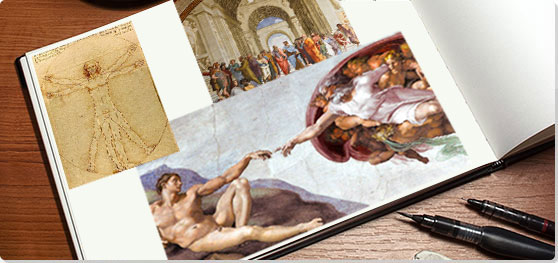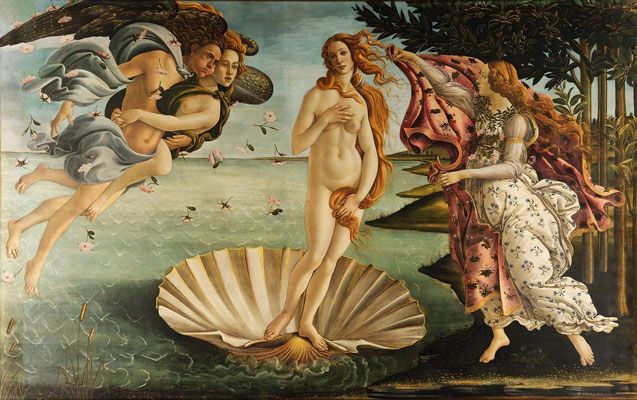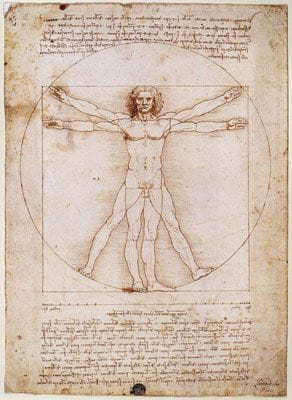Summary of High Renaissance
The High Renaissance, subsequently coined to denote the artistic pinnacle of the Renaissance, refers to a thirty-year period exemplified by the groundbreaking, iconic works of art being made in Italy during what was considered a thriving societal prime. A rejuvenation of classical art married with a deep investigation into the humanities spurred artists of unparalleled mastery whose creations were informed by a keen knowledge of science, anatomy, and architecture, and remain today, some of the most awe-inspiring works of excellence in the historical art canon.
Key Ideas & Accomplishments
- Although many artists vied for status and commissions during the High Renaissance, Leonardo da Vinci, Michelangelo, Raphael, and architect Donato Bramante are undoubtedly the period's most notable legends who exemplify the term "Renaissance" man in their proficiency and mastery of multiple subjects and interests.
- During this period, a cultural movement toward Humanism arose, compelling artists to return to Classical Roman and Greek philosophies concerning universal man and his place in the world. This was a departure from the medieval era's idealized religious iconography and resulted in fresh depictions of divine subjects infused with a more resonant and human emotionality and expression.
- High Renaissance artists utilized and perfected a bevy of techniques borrowed from Early Renaissance artists. This included the use of linear perspective to create extreme depth, highly accurate and scientifically correct depictions of human anatomy, the foreshortening of figures and subjects within elevated paintings and sculptures to provide an authentic viewing experience from below, and trompe l'oeil effects to seamlessly incorporate architectural elements into a work of art.
- A rise of new styles arose that were groundbreaking for the time. Leonardo created sfumato, a glazing effect that revolutionized the blending of tone and color, and quadratura, or ceiling paintings, were born, meant to rapturously draw the gaze of viewers up into a heavenly visage.
- The period is noted for infusing ideals of beauty back into art. Whether depicting religious figures or everyday citizens, in architecture and in art, the High Renaissance artists' key concerns were to present pieces of visual, symmetrical, and compositional perfection.
Overview of High Renaissance
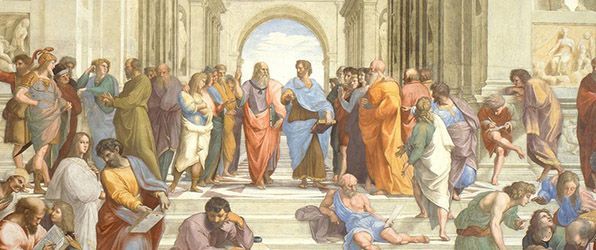
Celebrating, as he said, "the divine quality of the ancients' minds," Raphael portrayed a gathering of all the great classical thinkers in his Academy of Athens. At the same time his masterpiece epitomized High Renaissance ideals.
Artworks and Artists of High Renaissance
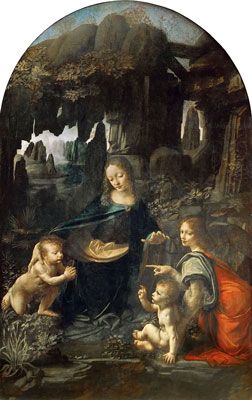
Virgin of the Rocks
This painting focuses on four figures: the Virgin Mary, John the Baptist and Christ as young children, and an angel. The Virgin is the central figure at the top of a pyramidal composition that emphasizes her importance, framed by rocks. Gazing downward, she reaches out her arm in blessing toward Christ but also outward to invite the viewer into this intimate scene. In the foreground, a pool is visible, with plants such as an iris and an aquilegia growing along its edges. The background is a dramatic vista of boulder formations, pinnacles rising up from earth, the shadowy depths of caverns, and an overarching roof of stone and fallen trees. Through the gaps, a sinuous river of blue green water moves toward the misty horizon on the upper left.
The title of the work originated from the mysterious and all-encompassing landscape that frames the sacred narrative. The vertical pinnacles and massive stone create a vivid contrast with the luminous figures, their curvilinear forms, and the softly draped clothing the Virgin and angel wear. The landscape is, as art critic Andrew Graham-Dixon wrote, "a fusion of fantasy and precise observation." The geological formation of the rocks and pinnacles resemble Italy's Dolomite mountains where Leonardo visited, writing in his 1480 notebooks: "Drawn by my eager desire I wandered some way among gloomy rocks, coming to the entrance of a great cavern, in front of which I stood for some time, stupefied and uncomprehending such a thing... Suddenly two things arose in me, fear and desire: fear of the menacing darkness of the cavern; desire to see if there was any marvelous thing within."
This painting was innovative for several reasons. Rather than depicting the Virgin as an idealized Queen of Heaven upon a throne with the customary halo, he created her as the Madonna of Humility, a version of Mary that would also be adopted by Raphael. Beauty and grace become the conveyor of the sacredness of the scene rather than traditional iconographic symbology, thus diffusing the boundaries between ordinary man and religious figures. This painting also pioneered the technique of sfumato to create the soft and gentle transitions of facial expressions to convey the fluidity of human interaction rather than a static, merely two-dimensional image.
Charles Hope, the art critic, wrote, "only Leonardo was able to capture movement and the play of emotion," an ability which the critic attributed to "his complete mastery of the drawing medium...Leonardo was the first to understand how to use the sketchy, spontaneous possibilities of drawings to develop coherent and lively compositions in his paintings."
There are two versions of this painting, though the second one featured in the National Gallery in London, has also been attributed, by some scholars, to Leonardo's assistants. However, both have been equally influential upon later artists.
Oil on panel - Musée du Louvre, Paris
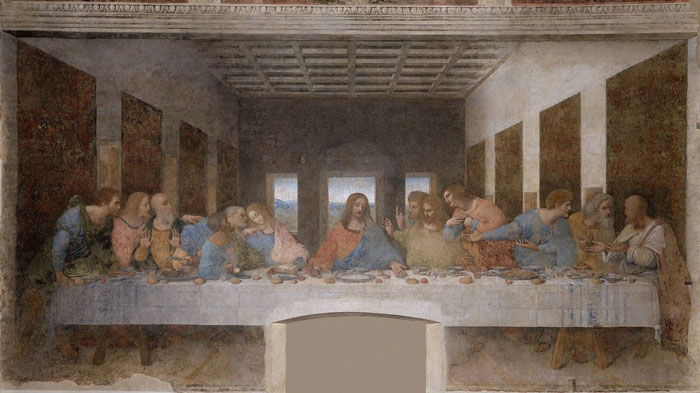
The Last Supper
This iconic work is one of the world's most recognizable paintings. It depicts Christ, his form creating a triangular hub in the center, from which flank his disciples seated beside him at the Last Supper on the eve of his most famous betrayal by Judas. The group sits behind a long rectangular table, which forms a boundary between the viewer and the occupants of this most sacred moment. The walls on either side create diagonals that narrow toward three open windows in the background behind Christ, further illuminating his central importance to the scene, and the powerful dramatic results obtained from the use of linear perspective.
In this work, Leonardo deviated from the tradition of depicting Judas separate from the group, and instead conveyed his betrayal by showing him stiffly hidden in shadow. Previous artists had portrayed this instance of Judas being named as the traitor, but Leonardo chose to paint, for the first time, the moment just before, when Christ said, "Verily I say unto you that one of you will betray me."
This artistic choice highlighted a tense psychological moment, showing how the disciples reacted, each in their own individual way that conveyed their deepest feelings. Leonardo wanted to portray the Apostles in motion, as each gesture conveyed the movement of the soul. As he wrote, "One who was drinking has left his glass in its place and turned his head towards the speaker. Another wrings the fingers of his hands and turns with a frown to his companion. Another with hands spread open to show the palms shrugs his shoulders up to his ears and mouths astonished. Another speaks into his neighbor's ear, and the listener twists his body round to him and lends him his ear while holding a knife in one hand and in the other some bread half cut through by a knife."
Along with his innovative approach to the subject matter, Leonardo's study of optics, shadow, and light inform the work, creating a sense of movement that flows through the group like a wave of emotion. As a result it becomes what art historian Jacob Burckhardt called a "restless masterpiece."
The artist's radical experimentation with media can also be seen. To achieve an effect like oil painting, Leonardo used oil and tempera to paint on a dry wall, after first applying plaster and then adding an underlying layer of white pigment to increase the vibrancy of the colors.
Also of interest is the way Leonardo integrated elements into the scene in regards to its location. Duke Ludovico Sforza commissioned the painting for the Convent of Santa Maria delle Grazie monastery's refectory, and the artist created it so that Christ and his disciples seemed to be an extension of the space where the monks ate dinner. By using Italian models for the disciples, depicting a Tuscan landscape, and including a plate of orange slices and grilled eel, a popular dish at the time, he brought ordinary elements that the monks would recognize into the famous religious scene.
Within the first few decades the paint started to deteriorate, and other events have damaged the work. Nonetheless, the work has had an extensive influence, being referenced in works by Salvador Dalí, silk screens by Andy Warhol, and works by the artist and filmmaker Peter Greenaway. One of the most popular and recognizable of artworks, it has been reproduced in countless consumer items from wall calendars to velvet tapestries. The contemporary art critic Peter Conrad wrote of the fresco, "I wonder if Leonardo didn't intend it to decay. He knew that creativity fights a losing battle with destruction and that art cannot outwit nature: what better way to illustrate those morbid truths than to produce a miraculously beautiful painting that almost immediately begins to revert, like the bodies and minds of all who look at it, to unformed chaos?"
Fresco-secco - Convent of Santa Maria delle Grazie in Milan

Tempietto
This image depicts the innovative Tempietto in the courtyard of the Church of San Pietro, cross-aligned with the spot where St. Peter was crucified. The round temple consists of a single chamber, inspired by Bramante's knowledge of classical buildings such as the Pantheon (113-125) and the Temple of Vesta (3rd century). It smoothly incorporates references from both Greek and Roman architecture into one unified effect. The sixteen columns that ring the building are a variation of the Doric column, which came to be called the Tuscanic column as it used a simpler round base and in its proportions followed the ratios of the Ionic column. The entablature above the columns depicts the keys of St. Peter and elements of the Catholic Mass. Above the columns a balustrade encircles the hemispheric dome, meant to symbolize the heavenly vault and the universe.
Bramante's original design placed the Tempietto within a circular courtyard, its columns and niches proportionally designed to radiate from the temple, making the building seem larger than it was. The plan was never completed, and subsequent building boxed in the temple, creating a cramped effect. Bramante wanted to create a building that was a perfect fusion of Humanist beliefs, derived from the classical world and Christian faith, as shown in the circular building's resemblance of both a Greek temple and the circular form traditionally used in tombs for Christian martyrs. The symmetrical design follows mathematical proportions derived from Leonardo's study of the Roman architect Vitruvius and his application of those proportions to the human body as seen in his Human Figure in a Circle and Square, illustrating Vitruvius on Proportion (1485-90), which Bramante studied when working with Leonardo for the Duke of Milan.
This building was considered to be an exemplary High Renaissance building, as reflected by architect Andrea Palladio in his treatise on ancient temples. Called a "jewel" of the Renaissance, the building also prefigured Bramante's design, though not carried out, for St. Peter's Basilica in the Vatican.
Masonry, Marble - Church of San Pietro in Montorio, Rome
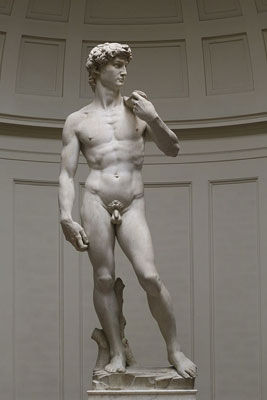
David
This famous statue, over 17 feet tall, shows the hero David as he faces the giant Goliath. His muscular figure both evokes classical Greek sculpture and departs from it, as his very long arms and large hands depict the awkwardness of adolescent growth. Michelangelo departed from previous treatments by not depicting Goliath or the moment after the battle, but instead showing the moment before, as David, his large eyes and prominent brow conveying concern, turns to assess the danger. A radical simplicity is employed here, as only the slingshot slung across David's shoulder identifies him as the Biblical hero. What matters is the classical depiction of a male nude, and, indeed, this work was the first time since the classical era that the male nude had been carved in a work of marble.
While the work has a classical effect, there are attributes that highlight distinct techniques of High Renaissance artists. Even though Michelangelo was a master of precise anatomical correctness in his figures, in this work the proportions deviate as the right hand is larger than the left, and David's eyes have an exodeviation, looking in two slightly different directions. This may be explained by the fact that the statue was originally intended to stand on the base of Brunelleschi's dome of the Florence Cathedral, causing it to be viewed from below on an elevated position, and that the artist created these tweaks in regards to that particular perspective, much in the same way that ceiling painters were foreshortening human figures for a more realistic viewing experience.
Other scholars have added to this notion, taking into account that the statue could have full effect only if the viewer, circumambulated it, developing a new concept of sculpture in relationship to the surrounding space. As art historian Lois Fichner-Rathus noted, "No longer does the figure remain still in a Classical contrapposto stance, but rather extends into the surrounding space away from a vertical axis. This movement outward from a central core forces the viewer to take into account both the form and the space between and surrounding the forms - in order to appreciate the complete composition."
Praising the work's "harmonious proportions and loveliness," Vasari wrote that, "Anyone who has seen Michelangelo's David has no need to see anything else by another sculptor, living or dead." He added, "this figure has put in the shade every other statue, ancient or modern, Greek or Roman."
Marble - Gallery of the Academy of Florence, Florence
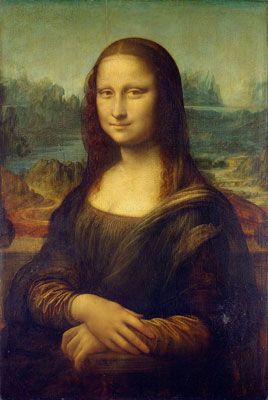
Mona Lisa
This most famous of paintings depicts a woman, dressed in fine fabrics of soft autumnal colors, in three quarters view, as she looks at the viewer with the hint of an enigmatic smirk. She sits in a chair, resting her arms on an armrest visible in the shadowed foreground, and is framed by a dramatic landscape of jagged mountain peaks, rock pinnacles, lakes descending in steep winding river canyons, and serpentine roads. The woman appears self-possessed, her presence resonant with a calm serenity. Because she is a woman of ordinary status, unattached to any political, historical, or religious importance, she has garnered a level of unparalleled cultural fascination with the mystery behind her legendary smile.
Leonardo's composition of Mona Lisa's figure was a radical innovation as all conventional portraits of the era depicted women in profile. Such portraits were often commissioned by male family members to portray a woman's social status and beauty. In contrast, Leonardo has left out the jewelry and decorative elements that focused on social standing and emphasized her personality.
Leonardo's groundbreaking realism was informed by his study of human anatomy, combined with a mathematical understanding of perspective and bodily proportions. This can be seen in the way he has the subject veer, almost imperceptibly, as her body, then her head, and finally her gaze turn a little more toward the viewer in a perfect imitation of reality. Vasari wrote, "As art may imitate nature, she does not appear to be painted, but truly of flesh and blood. On looking closely at the pit of her throat, one could swear that the pulses were beating."
The treatment of landscape was also innovative as two varied environments are seen on the left and on the right, lending a dramatic strangeness. The artist's mastery of aerial perspective to create depth and distance furthers the sense of being part of her individual existence of which we are being shown glimpses of both her interior and exterior emotional terrains, a very Humanist approach to portraying man's place in the world. As Louvre curator, Jean-Pierre Cuzin wrote, "The background may be a representation of the universe, with mountains, plains and rivers. Or possibly it is both reality and the world of dream. One could suppose that the landscape doesn't exist, that it is the young woman's own dream world."
The work's title La Giaconda, after Leonardo's model for the piece, Lisa Giaconda, wasn't widely used until the 1800s. It's believed Leonardo began painting the work sometime after his return to Florence in 1500, and that it travelled with him to France, remaining in his possession, as he worked on it until his death. The length of its creation suggests the centrality of the painting to his oeuvre, and furthers the High Renaissance's creative impetus to capture beauty as its utmost ideal. As Cuzin wrote "The entire history of portraiture afterwards depends on the Mona Lisa. If you look at all the other portraits - not only of the Italian Renaissance, but also of the seventeenth to nineteenth centuries - if you look at Picasso, at everyone you want to name, all of them were inspired by this painting. Thus it is sort of the root, almost, of occidental portrait painting."
The work has become so well-known that it has been referenced countless times in popular culture and parodied in works like Marcel Duchamp's famous LGOOQ (1919).
Oil on panel - Musée du Louvre, Paris
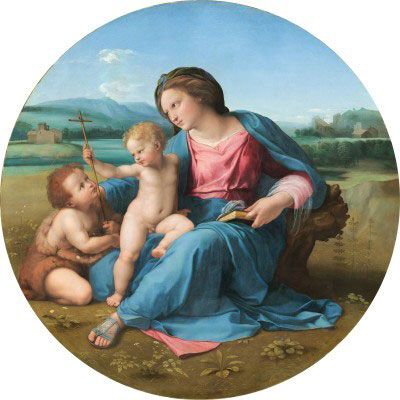
The Alba Madonna
This painting shows the Virgin Mary with child versions of Christ and John the Baptist in an Italian landscape. The facial expressions and body language, conveyed with a fluid and precise naturalism, are both remarkably human and spiritually expressive. The Virgin's gaze, as her right arm reaches out to touch John comfortingly on the shoulder, is portent with awareness of future events. He returns her look with understanding while his left hand grips the base of the wooden cross. The Christ Child reaches out to hold the cross, as he too gazes intently at John. The faces of the three figures become one cohesive glance of spiritual knowledge as visually a subtle diagonal is created from John at the left up to Jesus and the pinnacle of the pyramid at Mary's head. The idealized landscape creates a sense of serenity with its lake, green hills with several buildings, and a mountain range in the distance against a calm blue sky, where a drift of clouds, rising above Jesus's head are both naturalistic and allusive to the holy spirit.
This was one of Raphael's major works in the period following his move to Rome in 1508 to work under the Pope Julius II. It is a prime example of his depiction of the "Madonna of Humility," used often by both he and his artistic peers of the time, to represent an non-idealized vision of Mary as a woman/mother distinctly connected to everyday humankind. The use of the tondo, or round painting, further draws viewers in to the unified and intimate scene to provoke a feeling of profound relation.
Raphael's color palette was also innovative, employing delicate shades of pink, blue, and green, to create a delicate mood. As the legendary art historian Ernst Gombrich wrote, "if we compare it with the countless representations of the same theme which preceded it, we feel that they have all been groping for the very simplicity that Raphael has attained."
Oil on panel transferred to canvas - The National Gallery of Art, Washington DC
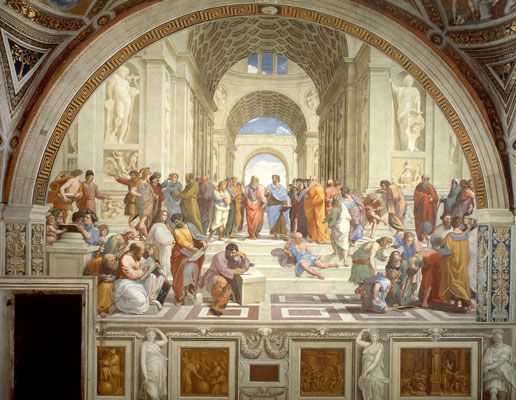
School of Athens
This fresco, depicting a gathering of classical Greek philosophers, noted contemporary scholars, and artists, uses perspective to draw the viewer's gaze toward the central figures of Plato on the left and Aristotle on the right, walking as they discuss philosophical matters under the replicating arches. The scene is animated, as groups in discussion cluster on both the left and right, creating a contrast with other individual figures that sit in solitary reflection. For example, the figure of Heraclitus (thought to be a portrait of Michelangelo) sits in the lower center, his head resting on his hand, as he seems to be sketching, while on the right of the stairs the cynic philosopher Diogenes sprawls. A statue of Apollo, god of music and art, stands on the left, while a statue of Athena, goddess of reason and wisdom stands on the right, symbolizing the division between Plato's philosophy of ideal forms and Aristotle's emphasis on logic and empirical knowledge.
By combining figures from the contemporary world with revered ancient Greeks, the work becomes a visual embodiment of the thriving Renaissance adoption of humanism. Raphael innovatively uses color to create a sense of dynamic intellectual movement, as notes of blue on the right and red on the left draw the eye along the diagonals created by the perspective toward Plato and Aristotle.
The architectural setting of the fresco seamlessly merges with the piece as a perfect example of trompe l'oeil. It is as if the wall itself is opening to reveal this spacious classical setting, its arches leading to the blue sky in the background. The building depicted is a Greek cross, and was influenced by the architect Bramante's designs. Later working as an architect, Raphael wrote that he hoped " to renew the beautiful forms of ancient buildings." As Jonathan Jones, the art critic noted, Raphael was prolific, in that he "does this not just in his architecture - little of which was ever completed - but in his paintings."
Fresco - Vatican City
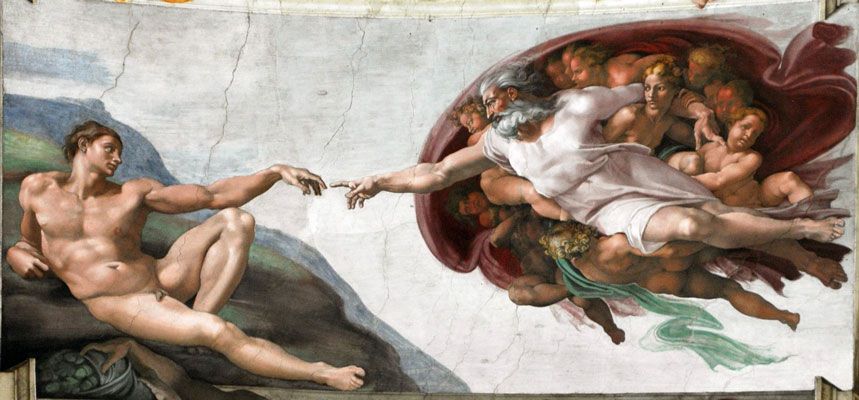
The Creation of Adam
This legendary painting, part of the vast masterpiece that adorns the Sistine Chapel, shows Adam as a muscular classical nude, reclining on the left, as he extends his hand toward God who fills the right half of the painting. God rushes toward him, his haste conveyed by his white flaring robe and the energetic movements of his body. God is surrounded by angels and cherubim, all encased within a red cloud, while a feminine figure thought to be Eve or Sophia, symbol of wisdom, peers out with curious interest from underneath Adam's arm. Behind Adam, the green ledge upon which he lies, and the mountainous background create a strong diagonal, emphasizing the division between mortal he and heavenly God. As a result the viewer's eye is drawn to the hands of God and Adam, outlined in the central space, almost touching. Some have noted that the shape of the red cloud resembles the shape of the human brain, as if the artist meant to imply God's intent to infuse Adam with not merely animate life, but also the important gift of consciousness.
The piece is an exquisite example of High Renaissance characteristics. Both figures are classical yet remarkably muscular and anatomically precise, informed by Michelangelo's sculptural approach and his knowledge of human anatomy. Whereas prior Christian art had previously connected the nude figure to shame and sin, reserving its presentation for demonic figures or depictions of Adam and Eve driven out of paradise, here, the nude is utilized to create a powerful depiction of profound male beauty. Pope John Paul II said, "The Sistine Chapel is precisely - if one may say so - the sanctuary of the theology of the human body," because of its endless number of portraits of figures from religious narrative that are displayed in all their stark, naturalistic, human glory.
In fact, it was Pope Julius II who convinced Michelangelo to paint the now iconic space in 1508, pulling him off another job to design the papal tomb in order to work on what is now considered one of the world's most revolutionary masterworks. The vast murals, which cover the ceiling and and walls of the chapel, employ foreshortening, the painting of illusionary architecture, a luminous color palette, dynamic movement, and the artist's distinctive figurative treatment in its complex structure of various scenes from the Bible.
The Sistine Chapel ceiling became the visual representation of Renaissance ideals, as Vasari wrote, "The work has proved a veritable beacon to our art, of inestimable benefit to all painters, restoring light to a world that for centuries had been plunged into darkness. Indeed, painters no longer need to seek for new inventions, novel attitudes, clothed figures, fresh ways of expression, different arrangements, or sublime subjects, for this work contains every perfection possible under those headings."
Many subsequent artists have studied and attempted to imitate parts of the work for what art historians Gabriele Bartz and Eberhard König called its "unprecedented invention."
Fresco - Vatican City
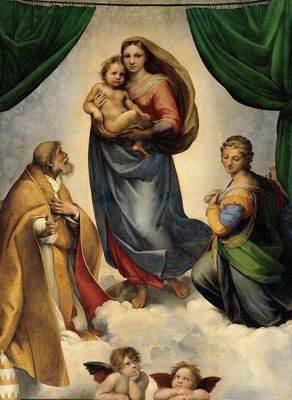
The Sistine Madonna
The Sistine Madonna presents a serene, self-possessed Virgin Mary with the Christ child, a woman of ideal maternal splendor and beauty. She stands on the clouds front and center, robes flowing, with curtains drawn on either side of her to emphasize her importance. The view behind her opens into heaven, as the faces of the souls of unborn children or angels throng in the clouds. Two third-century martyrs, patron saints of the church of San Sisto, meet her. On her left, Pope Sixtus II, kneels to gaze up at her, his left hand above his heart, and his right hand inviting the viewer forward. On the right, Saint Barbara kneels, her face turned toward the viewer and downward toward the two impish cherubim staring up from the bottom.
In Raphael's time such compositions, styled much like stage settings where central characters were framed by drapery or other delineating elements, were common for the tombs of the wealthy, presenting a grand entrance after death into heaven. This Madonna, thought to be modeled after the artist's lover Margheriti Lutti, creates that effect of classical nobility, albeit lent to a woman of historical religious importance. Representing not only the divine mother, she is seen to represent the beautiful gravity and lightness of the universal concept of mother.
Raphael's innovation to a traditional subject was his addition of light, witty, human elements, particularly seen in the cherubs at the bottom center. Like little boys restless with waiting, the one on the right almost rolls his eyes while the one on the left with his chin in his hand stares into space as if bored at church. They add a sweet and impish element of reality that makes the other figures more convincing and grounds the painting as a marriage of ethereal spirituality and emotional humanity. The touch of realistic ordinary human behavior can also be seen in the Pope having taken off his miter, placed in the lower left of the canvas, like a man taking off his hat to honor the Virgin. As art historian Bette Talvacchia wrote, "His art never fails to engage the viewer's imagination, whether through the mesmerizing, graceful beauty of his Madonnas, the perfection of his classicizing forms, or the inescapable pull of his narrative scenes."
This painting became wildly influential, following its being moved in 1754 to Dresden, Germany where it became particularly important to the works of Johann Joachim Winckelmann, pioneer of the study of art history, who saw in it a kind of vision unifying classical and Christian elements. A German legend developed that Raphael had painted it from having a religious vision, and the work was widely believed to have miraculous power. The art historian Gombrich has written about Raphael, that his "best works give us a glimpse into a world more serene and harmonious than our own."
The legend of Raphael and the inspiring nature of the work informed the Romantic movement and had a great influence on the German writer and scholar Goethe, the musician Wagner, and the philosopher Nietzsche. The great Russian novelist Dostoevsky called it "the greatest revelation of the human spirit," thus echoing what Vasari had said of the work in the 1500's, "a truly rare and extraordinary work." Raphael also influenced modern artists like Pablo Picasso, who said, "Leonardo da Vinci promises us heaven. Raphael gives it to us." The image of the cherubim alone has had an extensive popular culture presence, being featured on contemporary postcards, U.S. stamps, T-shirts, and other consumer items.
Oil on canvas - Gemäldegalerie Alte Meister, Dresden
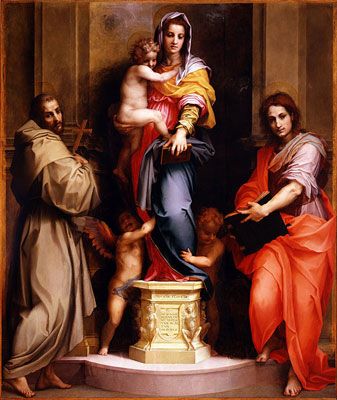
Madonna of the Harpies
This painting focuses on the motif of the sacra conversazione, a term developed in the 18th century for paintings that depicted the Virgin with Christ as Child with a few saints in attendance. Yet, as is also common with this motif, she is shown in a scene that has been reduced in serious historical levity to present Mary as a resonant figure to common man. Modeled on the artist's wife Lucrezia, she stands on a golden pedestal holding Jesus with her right arm and a sacred text in her left. Two mischievous putti (chubby male-derived angels) clasp her legs, their dynamic movements and facial expressions suggesting that they are playfully engaging with her. To the right John the Evangelist, wearing a red flowing robe, and holding out a large book alluding to his Revelation, faces toward the viewer. On the left, Saint Francis, the patron saint of the church that commissioned the work, is shown in profile, holding a wooden cross as he, too, turns toward the viewer.
Early examples of sacra conversazione were Fra Angelico's Annalena Altarpiece (1438-1440) and Domenico Veneziano's Santa Lucia de Magnoli Altarpiece (1445-1447). The artist here has continued the genre but added the dynamic energy characteristic of High Renaissance art, as the art historian Nigel Gauk-Roge wrote, "so that a composition of fundamentally classical purity is animated by a nervous energy in the figures to produce an unsettling impression of variety."
Also in this piece, Del Sarto employs many signature technical methods of the High Renaissance painters. He uses a pyramidal composition to position Mary as the pinnacle, as the vertical lines and varying light and dark planes of the background both draw the eye upward and create a sense of classical order. Each figure has a contrapposto pose, with weight focused on one leg, as seen in Mary's left knee prominently forward, and, even Jesus with his right foot putting his weight on the Bible, which creates a sense of impending movement. The fabric folds creating shadowy contours and illuminated planes of color emphasize the sense of vigorous energy, caught in the moment. The artist presents the Christ Child as younger and with an almost athletic build, showing off a distinct familiarity with authentic anatomy.
The work's title was coined after the painting's creation and alludes to the two women, portrayed on the base of the pedestal, which Vasari identified as harpies from classical mythology. They may also represent the personified locusts described by St. John in his Book of Revelation. In either case, they allude to temptation and sin, conquered by the Virgin as she stands upon them. Though animated, the figures seem to inhabit their own internal space, as only the children interact, and a kind of aloofness and dissonance is conveyed. This sense of animated movement, combined with a nervous energy that conveyed the psychological character of his subjects, was the artist's innovative addition to the High Renaissance. His work was an influential prefiguring of Mannerism.
Oil on panel - The Uffizi Gallery, Florence
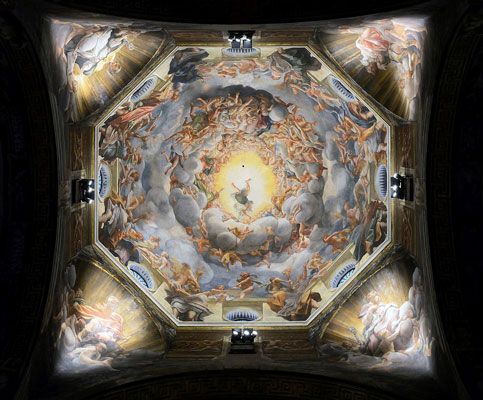
The Assumption of the Virgin
This ceiling fresco depicts the Assumption of the Virgin as she is lifted upward by a swirling spiral of angels. Many holy figures are arranged against the heavenly clouds in a concentric composition, creating a kind of vortex that draws the viewer's eye toward the golden light at the center where Jesus is descending to meet his mother. The dome's base depicts the patron saints of Parma - St. John the Baptist, St. Thomas, St. Bernard, and St. Hilary, shown with associated symbols, which identify them. Also ringing the dome's base are the disciples who react to Mary's empty tomb and the scene before them.
Two revolutionary techniques, signature to the High Renaissance, were used to create a sense for viewers that they were indeed a part of this divine work. Extreme foreshortening was used in the figurative treatment of Jesus to create an authentic perspective when seen from below. The artist also created a unified pictorial space by including all of the architectural surfaces so that the vault of heaven seemed to open up within the church from above. As the viewer looks up at this work of di sotto in su, meaning 'viewed from below,' bright color and clear light create an illusion of depth and weightlessness.
The artist has also arranged the narrative strategically, so the viewer gradually enters the scene. As one approaches the altar beneath the dome, St. Hilary and St. John the Baptist, first become visible. On closer approach, the Apostles come into view. Finally, the Virgin appears, and then the center with Jesus.
The work was informed by contemporary events, notably Martin Luther's 1517 Protestant Reformation, which directly critiqued the Catholic Church. This awe-inspiring treatment of the Assumption of Mary emphasized the divine authority of the Church, by depicting the Catholic belief that at death, she was assumed bodily into heaven, a belief not shared by Protestantism. Emotionally, the scene is also a joyful reunion of the Virgin with her son and, thus, alludes, to Parma's return to the Papal States, and the hope that Protestant congregations would likewise return to the true Church.
This work greatly inspired, and became a model for, later Baroque and Rococo artists like Carlo Cignani, Giovanni Lanfranco, Pietro de Cortona, and Andrea Pozzo who would use the trompe l'oeil effect alongside their emphasis on grandeur.
Ceiling fresco - Cathedral of Parma, Parma
Beginnings of High Renaissance
The Term Renaissance
It wasn't until 1855 that a French historian named Jules Michelet first coined the word "Renaissance" to refer to the innovative painting, architecture, and sculpture in Italy from 1400-1530. His use of the term was informed by Renaissance historian Giorgio Vasari's mention of "rebirth" to describe the same period in his The Lives of the Most Excellent Painters, Sculptors, and Architects (also known as Lives of the Artists) (1568).
The term was informed by 18th century archeologist and art historian Johann Joachim Winckelmann's The History of Ancient Art in Antiquity (also translated as The History of Ancient Art) (1764) characterizing the Classical art of the Greeks as the "High Style." Winckelmann's ground-breaking book launched the study of art history and became foundational to European intellectual life, as well as reaching a popular audience. He felt that the purpose of art was beauty, an ideal obtained by the Greeks and in High Renaissance art, as he wrote, "the Italians alone known how to paint and figure beauty."
By the early 1800's the term Hochenrenaissance, German for High Renaissance, was used to refer to the period, defined as beginning around the time of Leonardo da Vinci's The Last Supper (1490's) and ending with the Sack of Rome by the army of Emperor Charles V in 1527. In the last thirty years, some contemporary scholars have criticized the term as being an oversimplification.
The Transition from the Early Renaissance
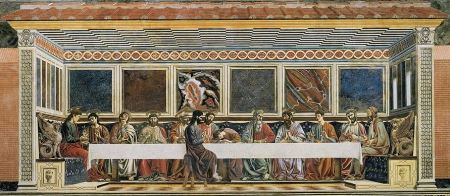
High Renaissance artists were influenced by the linear perspective, shading, and naturalistic figurative treatment launched by Early Renaissance artists like Masaccio and Mantegna. But they mastered those techniques in order to convey a new aesthetic ideal that primarily valued beauty. The human figure was seen as embodying the divine, and new techniques like oil painting were employed to convey human movement and psychological depth in gradations of tone and color. Drawing upon the classical Greek and Roman proportional preciseness in architecture and anatomical correctness in the body, masters like Leonardo, Michelangelo, and Raphael created powerful compositions where the parts of their subjects were illustrated as harmonious and cohesive with the whole.
Leonardo da Vinci
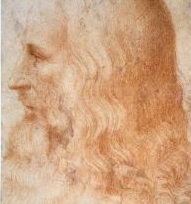
The High Renaissance began with the works of Leonardo da Vinci as his paintings, The Virgin of the Rocks (1483-1485), and, most notably, The Last Supper (1490s), exemplified psychological complexity, the use of perspective for dramatic focus, symbolism, and scientifically accurate detail. However, both works were created in Milan, and it wasn't until 1500 when Leonardo moved back to Florence, the thriving center of art and culture, that his work impacted the city. His study for The Virgin and Child with St. Anne (c. 1499-1500) was displayed at Santissimi Annunziata church where many artists went to study it.
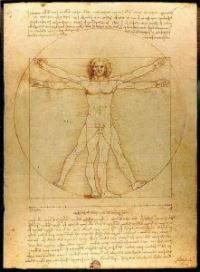
Leonardo's scientific understanding and observation of natural phenomena and his sense of mathematical proportion were also profoundly influential. His seminal ink drawing Vitruvian Man (1490) showed ideal human proportions correlating with ideal architectural proportions advanced by the Roman architect Vitruvius in his De architectura (30-15 BCE). The drawing is occupied by Leonardo's writing that illustrates his deep scientific inquiries into anatomy as, for example, "the length of the outspread arms is equal to the height of a man."
Leonardo was not only a noted painter, but also a polymath who has been called the father of architecture, ichnology, and paleontology, among other fields. He was a noted inventor, cartographer, engineer, and his findings and observations, recorded in his notebooks, found their way into various collections, called the Codex Arundel (1480-1518) and Codex Leicester (1510), among others. To some, these notebooks have become as valued as his artworks.
An Age of Masters and Rivalries
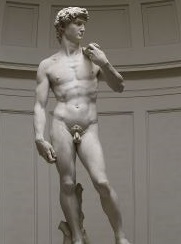
The High Renaissance was dominated by a few celebrated masters and the competitive rivalries that developed between them as they vied, not only for noble patronage, but also for supreme excellence in their art. In Florence, at the same time that crowds gathered to view Leonardo's cartoon for The Virgin and St. Anne (c. 1499-1500), Michelangelo had become a rising star with his creation of the Pietà (1496-1498).
Michelangelo viewed sculpture as the pre-eminent art and, even in painting, sculpted the human form. With the creation of the iconic statue David (1501-1504), his reputation as the sculptor whose works exemplified the High Renaissance was established. David was given a central place in the city of Florence, upholding the city-state's spirit of defending its civil liberties.
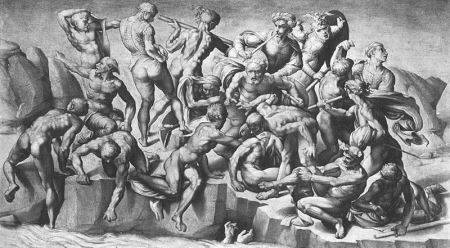
A rivalry developed between Michelangelo and Leonardo, beginning in 1504 with their competing frescoes commissioned for opposing walls in the Hall of Five Hundred. As art critic Jonathan Jones wrote of Michelangelo, "He was fiercely competitive and needed to outdo Leonardo. It became a contest not of skill, in which they were both beyond compare, but imagination and originality. Leonardo, the older artist, was already famous not just as a gifted painter but a truly original mind... [Michelangelo] set out his claim to a similar kind of personal, unique vision." That personal vision can be seen in the artist's choice of a battle scene where nude bathers were attacked, thus allowing for a dynamic, and essentially sculptural, treatment of the male nude.
The two frescos, Leonardo's The Battle of Anghiari (1503-1506), and Michelangelo's Battle of Cascina (1504-1506), were unfortunately not completed, as both men were pulled toward other commissions. Nevertheless the works continued to influence other artists, notably Raphael, who would go on to copy the masterpieces in efforts to further their own artistic practices.
Pope Julius II
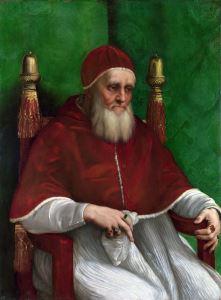
Rome became the artistic center of the High Renaissance due to the patronage of Pope Julius II, who reigned from 1503-1513. Julius II was a noted art collector, owning the Laocoon (c. 42-20 BCE) and the Apollo Belvedere (c. 120-140), along with other noted classical works, which became the foundation for the Vatican's art museums. He was a formidable personality who made the Papacy into an economic and military force that dominated much of Italy. His goal was to make Rome the cultural center of Europe instead of Florence. To achieve this, he ardently pursued the great artists of the day, persuading Raphael to move to Rome to paint the frescoes of the Vatican's papal apartments. After commissioning Michelangelo to create the papal tomb. he cajoled the reluctant sculptor into painting the Sistine Chapel ceiling (1508-1512). The Pope's ambition to rebuild St. Peter's Basilica and redesign the Vatican led him to recruit Bramante, Michelangelo, and Raphael into roles as architects of his grand plans. After Julius II's death, papal patronage of the arts continued under Pope Leo X, the son of Lorenzo de' Medici, patriarch of the ruling (and art loving) family of Florence.
High Renaissance: Concepts, Styles, and Trends
Renaissance Man
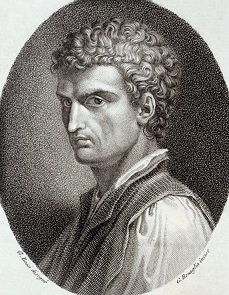
During the Early Renaissance years, the concepts of Humanism were widely promoted. Whereas the previous Gothic period's art had emphasized the idolization of the secular and the religious, artists in 14th century Florence were more concerned with man's place in the world. High Renaissance artists evolved this inquiry by exploring the concept of "universal man," in other words, an individual of genius, divinely inspired, who could excel in all aspects of art and science. The term "Renaissance man" is still used today to describe a well-rounded and multi-talented person who exhibits mastery in a wide array of intellectual and cultural pursuits.
This ideal, developed from Leon Battista Alberti's "A man can do all things if he will," was exemplified in Leonardo da Vinci, as Vasari in his Lives of the Artists (1568) wrote, "In the normal course of events many men and women are born with remarkable talents; but occasionally, in a way that transcends nature, a single person is marvelously endowed by Heaven with beauty, grace and talent in such abundance that he leaves other men far behind, all his actions seem inspired and indeed everything he does clearly comes from God rather than from human skill. Everyone acknowledged that this was true of Leonardo da Vinci, an artist of outstanding physical beauty, who displayed infinite grace in everything that he did and who cultivated his genius so brilliantly that all problems he studied he solved with ease."
This standard not only dominated the period but subsequent thinking on artistic ability, positioning the artist as a divinely inspired genius, rather than merely a noted craftsman.
Innovations in Painting
While High Renaissance painting continued the tradition of fresco painting in connection with religious scenes, the practice of masters like Raphael, Leonardo, and Michelangelo was informed by innovations of the medium. For example, to paint the Sistine Chapel, Michelangelo not only designed a scaffolding system to reach the area but developed a new formula and application for fresco to counter the problem of mold, as well as a wash technique and the use of a variety of brushes, to first apply color then, later, add fine detail, shading, and line. For his Last Supper (1490s), Leonardo experimented by working on dry fresco and used a combination of oil and tempera to achieve an oil painting effect. Raphael, Leonardo, and Michelangelo all employed trompe l'oeil in their frescoes, a technique by which to achieve the illusion of a pictorial space that integrates into its surrounding architectural environment.
At the same time, many masterworks of the High Renaissance were, for the first time, being painted in oil, typically on wood panels but sometimes on canvas. Because oils provided more possibilities in subtle tonal and color gradations, the resulting works were more life-like. As a result, a new body of compelling portraiture of ordinary people emerged. Leonardo's Mona Lisa is undoubtedly the most famous example. Other High Renaissance artists like Andrea del Sarto in his Madonna of the Harpies (1517) and Fra Bartolomeo in his Portrait of Girolamo Savonarola (c. 1497-1498) also created powerful works in oil.
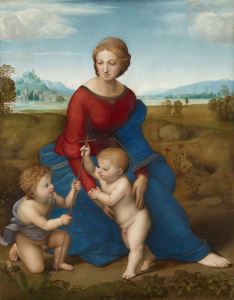
Leonardo's practice of oil painting led him to develop a new technique called Sfumato, meaning "vanished gradually like smoke." It involved using translucent glazes worked by brush to create gradual transitions between tones of light and shadow. The result was, as Leonardo wrote, "without lines or borders, in the matter of smoke," creating a vivid imitation of reality lacking all evidence of the artist's brushstrokes. Other High Renaissance artists like Raphael, Fra Bartolomeo, and Correggio also mastered the style, which later greatly influenced Renaissance painters of The Venetian School like Giorgione, and later, the Mannerist painters.
Quadratura
Quadratura was the term used for the burgeoning ceiling paintings genre of the time, remarkable for the way they unified with the surrounding architecture, and known for their employment of trompe l'oeil. These works not only included the seamless integration between painting and location, but also oftentimes required the creation of fictive architectural features to visually reconfigure the site. The use of quadratura was used often in Catholic churches to produce an awe-inspiring effect, which was in direct opposition to the movement toward Protestantism that would later become the Reformation.
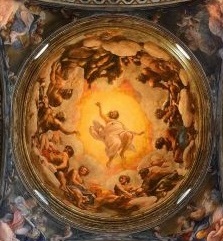
Quadratura required visual-spatial skill and a masterful employment of linear perspective that had first been pioneered by Andrea Mantegna in his Camera degli Sposi (1465-1474) ceiling in the Ducal Palace of Mantua. His work notably influenced Antonio Allegri da Correggio, known simply as Correggio, the leader of the High Renaissance in Parma.
Correggio's ceiling frescos, Vision of St. John the Evangelist on Patmos (1520-1521) and Assumption of the Virgin (1524-30), further developed the illusionary effects of quadratura through his use of new revolutionary techniques like the foreshortening of bodies and objects so that they appeared authentic when seen from below. This method, also known as prospettiva melozziana, or "Melozzo's perspective," was developed by Melozzo da Forlì, an Italian artist and architect.
Architecture
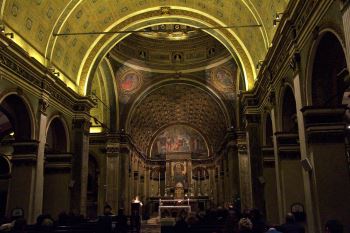
The leading architect of the High Renaissance was Donato Bramante, most noted for his emphasis on classical harmony, employment of a central plan, and rotational symmetry, as seen in his Tempietto (1502). Rotational symmetry involved the use of octagons, circles, or squares, so that a building retained the same shape from multiple points of view. He also created the first trompe l'oeil effect for architectural purposes at the church of Santa Maria presso San Satiro in Milan. Due to the presence of a road behind the wall of the church, only three feet remained for the choir area, so the architect used linear perspective and painting to create an illusionary sense of expanded space.
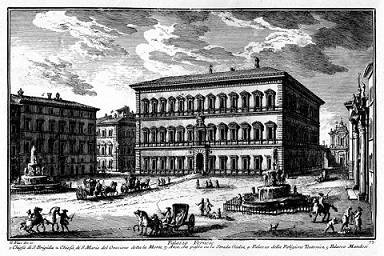
Bramante's student Antonio da Sangallo the Younger designed the Palazzo Farnese which was called by Sir Barister Fletcher, "The most imposing Italian palace of the 16th century." The design adhered to classical principles, had a Spartan simplicity, and used rustication, which left the building stone in its textured and unfinished state allowing for natural lines and color. The era, however, was marked by competing designs and personal rivalries. Cardinal Farnese who became Pope Paul III in 1534 was dissatisfied with the cornice design of the Palazzo and held a competition for a new design, which was awarded to Michelangelo. The popular story recounts how Sangallo the Younger died of shame the following year, as Michelangelo completed the building's final touches.
Michelangelo was Bramante's chief rival, as, in later life, he worked as an architect. He designed the Laurentian Library in Florence and created the dome for St. Peter's Basilica, though the building as a whole reflected the work of Bramante, Raphael, and later architects like Bernini. This work, which took place between 1523-1571, was particularly innovative; creating a dynamic sense of movement in the staircase and wall features that was influential upon later architects.
Sculpture
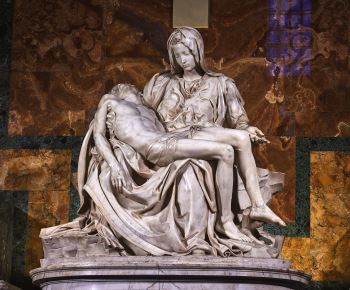
The undoubted master of sculpture during the High Renaissance was Michelangelo whose Pietà, (1498-1499), finished when he was only twenty-four, launched his career. He chose to depict an unusually youthful Virgin Mary holding the dead Christ in her lap. Although the treatment of this scene was popular in France, it was entirely new to Italian art. The work's pyramidal composition and naturalistic figurative treatment created a powerfully classical effect. Yet, the work also showed innovative variations. The monumental scale of the Virgin in comparison to Christ lent a highly emotional maternal aspect to the piece and became a signature method for the artist in his work, this manipulation of high contrast. Unlike Early Renaissance sculptors like Donatello who worked in bronze, Michelangelo single handedly revived the classical use of marble, and injected elements of monumentality into all of his subsequent sculptures, both in the size of the figures, and the scale of the projects.
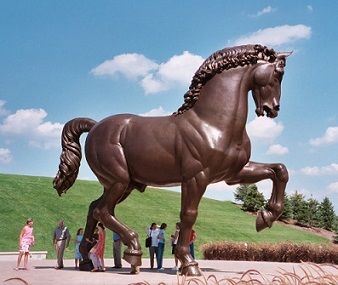
Leonardo also explored sculpture, notably designing the world's largest bronze equestrian statue. Commissioned by the Duke of Milan in 1482 to honor his father, the project was never completed, as the artist's 24-foot tall clay model was destroyed by the French army invasion of Milan in 1499. Several versions of the horse, based upon the artist's drawings, have been completed in modern times.
Later Developments - After High Renaissance
The ideals and humanism that informed the High Renaissance continued to inspire the world beyond Italy, albeit with notable stylistic and artistic variation. Its influence would reach into the North European Renaissance, exemplified by Albrecht Dürer, Pieter Bruegel, and others, and the Venetian Renaissance and the Venetian School of Painting, led by Giorgione and Titian and the architect Palladio. Meanwhile, Correggio's quadratura works influenced the artists Carlo Cignani, Gaurdenzio Ferrari, Il Pordenone, and had a notable impact on Baroque and Rococo treatments of domes and ceilings.
Leonardo's death in 1519, followed by Raphael's death when he was only 37 years old the following year, marked a lessened vibrancy of the Italian High Renaissance. The sack of Rome by the armies of Holy Roman Emperor Charles V in 1527 ended the era. The brutal and terrifying event reduced the population of Rome from 55,000 to 10,000, and left the city in a state of collapse and financial ruin. The ideals of the High Renaissance no longer seemed tenable to many. Michelangelo's Last Judgment (1536-41) a fresco in the Sistine Chapel expressed the darker emotional tenor of the following decades. In sculpture he turned to pietas and depictions of captive slaves such as his The Atlas Slave (1530-34).
Michelangelo later approaches in expression influenced the Mannerists, including Jacopo da Pontormo, Rosso Fiorentino, Giorgio Vasari, and Francesco Salviati. His figurative treatment, particularly of the male nude, influenced countless artists. Later artists of the Baroque period, the Neoclassicists, and the avant-garde movements of the 20th century were also widely influenced by the works of the Renaissance. For instance, Pablo Picasso drew upon Raphael in his Guernica (1937), referencing The Fire in the Borgo (1514), which depicted a woman handing her baby to those below as she leaned out of the burning building.
The works created by the artists of the Italian High Renaissance remain the most recognizable and popular works of art history. The Mona Lisa, The Last Supper, The Creation of Adam, and The Sistine Madonna, have been reproduced on countless consumer items, referenced in popular songs, TV shows, videos, and often used in advertising.
Furthermore, the ideas of the High Renaissance - the artist as genius, the foundational nature of classical art, the individual as center of the universe, the value of science and exploration, the emphasis on Humanism - have all deeply informed the social and cultural values of the world ever since.
Useful Resources on High Renaissance
-
![Leonardo's Universe: National Geographic Documentary]() 669k viewsLeonardo's Universe: National Geographic DocumentaryOur Pick
669k viewsLeonardo's Universe: National Geographic DocumentaryOur Pick -
![Leonardo da Vinci Documentary]() 0 viewsLeonardo da Vinci DocumentaryHistory Channel
0 viewsLeonardo da Vinci DocumentaryHistory Channel -
![Secrets of the Mona Lisa]() 0 viewsSecrets of the Mona Lisa2015 Documentary / Discovery Channel
0 viewsSecrets of the Mona Lisa2015 Documentary / Discovery Channel -
![Raphael: A Mortal God]() 541k viewsRaphael: A Mortal GodOur PickBBC
541k viewsRaphael: A Mortal GodOur PickBBC -
![Michelangelo Artist and Man: Documentary]() 226k viewsMichelangelo Artist and Man: DocumentaryOur Pick
226k viewsMichelangelo Artist and Man: DocumentaryOur Pick -
![Raphael's Fresco of the Disputa of the Vatican's Stanza della Segnatura]() 33k viewsRaphael's Fresco of the Disputa of the Vatican's Stanza della SegnaturaColumbia
33k viewsRaphael's Fresco of the Disputa of the Vatican's Stanza della SegnaturaColumbia - The Genius of Leonardo da VinciCBS New
-
![Mercedes T. Bass Lecture: Leonardo da Vinci and His Genius]() 903 viewsMercedes T. Bass Lecture: Leonardo da Vinci and His GeniusThe Aspen Institute
903 viewsMercedes T. Bass Lecture: Leonardo da Vinci and His GeniusThe Aspen Institute -
![Leonardo da Vinci Drawings]() 36k viewsLeonardo da Vinci DrawingsHelen Burnham, Pamela and Peter Voss Curator of Prints and Drawings / Boston Museum of Fine Arts
36k viewsLeonardo da Vinci DrawingsHelen Burnham, Pamela and Peter Voss Curator of Prints and Drawings / Boston Museum of Fine Arts -
![Looking Back on Leonardo]() 60k viewsLooking Back on LeonardoOur Pick
60k viewsLooking Back on LeonardoOur Pick -
![Leonardo Sculpture]() 3k viewsLeonardo SculptureMarietta Cambareri and Jetskalina H. Phillips / Museum of Fine Arts, Boston
3k viewsLeonardo SculptureMarietta Cambareri and Jetskalina H. Phillips / Museum of Fine Arts, Boston -
![Raphael's Vision: A Discussion of the Paintings in the Stanza Della Segnatura in the Vatican]() 9k viewsRaphael's Vision: A Discussion of the Paintings in the Stanza Della Segnatura in the VaticanFr. James Lehrberger
9k viewsRaphael's Vision: A Discussion of the Paintings in the Stanza Della Segnatura in the VaticanFr. James Lehrberger -
![Michelangelo as Draughtsman]() 18k viewsMichelangelo as DraughtsmanTalk by Hugh Chapman / Museum of Fine Arts, Boston
18k viewsMichelangelo as DraughtsmanTalk by Hugh Chapman / Museum of Fine Arts, Boston -
![The unheard story behind the Sistine Chapel]() 269k viewsThe unheard story behind the Sistine ChapelOur PickTed talk by Elizabeth Lev
269k viewsThe unheard story behind the Sistine ChapelOur PickTed talk by Elizabeth Lev -
![Francis Broun on the Sculpture of Michelangelo]() 9k viewsFrancis Broun on the Sculpture of MichelangeloOur Picktvo channel
9k viewsFrancis Broun on the Sculpture of MichelangeloOur Picktvo channel -
![Michelangelo and the Intrigue of Drawings]() 14k viewsMichelangelo and the Intrigue of DrawingsJulian Brooks, curator, Department of Drawings, J. Paul Getty Museum
14k viewsMichelangelo and the Intrigue of DrawingsJulian Brooks, curator, Department of Drawings, J. Paul Getty Museum -
![Raphael School of Athens]() 0 viewsRaphael School of AthensColumbia University
0 viewsRaphael School of AthensColumbia University
